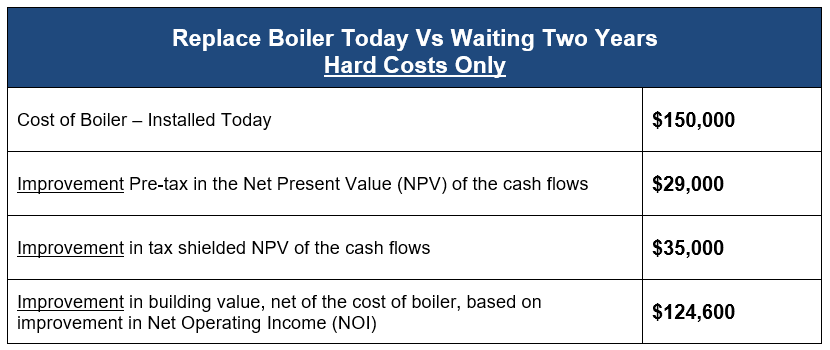What if I told you that even though your boiler has two years left of life, now is the right time to replace it? You might call me out – like one savvy apartment owner did recently. With 10 million owned and managed units to consider, he asked “Why does that make any business sense? I’d go bankrupt with that kind of logic. I don’t replace a boiler until it dies!”
This reaction is expected – and common. The truth is, each building and situation must be evaluated on a case by case basis as circumstances, costs, and boilers improve and change. I told the apartment owner I’d be happy to do the financial analysis on one of his existing buildings where the boiler is two years prior to replacement. I proposed analyzing that building, not creating a general rule of thumb. He was happy to spend my time!
First, I gathered information and assumptions about the building, such as the difference between the efficiency of replacement equipment and the actual efficiency of the building’s twenty year old boiler, the installed replacement price of a new boiler, the budget for repairs over the next two years, whether the boiler had broken down and led to management time spent and tenant discomfort, etc.
Based on the information provided – the following came out of the analysis:

Lesson learned
In this case, the financial results point directly to replacing the boiler today solely on the improvement in the building’s value and the lowering of annual hard costs to operate the boiler. What does not show in the above analysis is that the pre-tax net present value (NPV) is negative for both options. You can do the project now or wait – but there is still an economic improvement with the retrofit as it reduces the amount of the negative NPV. In an after tax analysis, the NPV is positive if the equipment is replaced today and negative if replaced in two years. Therefore, the cost of waiting is the lost improvement in NPV. On the basis that cash is king, not replacing the boiler leaves money on the table.
Not For Profit Scenario
What does this mean for a not for profit where no tax analysis is required? The NPV to replace the asset today is negative but still better. An improvement in NPV has a positive financial impact on any organization. The “pain” is therefore reduced for an asset that is mission critical. The building can’t do without one.
Sunk Cost
In either case the existing boiler is a sunk cost, meaning it’s a cost that can’t be recovered. Since it’s a historical cost it should not be factored into the future analysis. What also then would be the chance of recovering the investment in a boiler that has been in the building for say, fifteen years? What are the chances of recovering the repair costs on an old boiler? The answer is most likely slim to none.
Competition for capital
No analysis should be done in isolation. Capital is always in short supply and most organizations have other needs and must consider the urgency of the need in choosing between one project or another. Comparative analysis should be done. A roof that needs replacing because leaks are causing structural damage and tenant displacement may take precedent if choices mean reduced revenue or if deferring a repair would cause significant additional cost later.
Financing the project
When does financing make sense? Each situation is unique, but when there is limited capital and more than one project requiring it, it is smarter to finance the project with the highest NPV. Another approach is using a down payment and obtaining partial financing, which can serve to make the remaining investment cash flow neutral or NPV positive. When there is a need to preserve capital for other projects, financing can be a useful tool.
Integrating other energy efficiency measures
A common practice when looking at energy projects is the combining of other energy reduction measures that have positive cash flows. This project approach can create a very positive NPV. A full comprehensive retrofit is most desirable, but when a need has to be met, then a project that is NPV positive makes good business sense.
Opportunity Cost
There is an opportunity cost involved in the doing the analysis. Management and staff time is valuable. Using staff time to manage building issues that are less productive or financially beneficial can be as costly. The opportunity cost dealing with boiler replacement and repair may take away from sales or refurbishment. In this case, the gathering of the information and analysis took 12 hours and produced an after tax shield NPV gain of $35,000 and net gain in the value of the property of $124,600. If the cost of the analysis and time to manage the project to replace the boiler is determined as $6,000, the return is very positive. For a $6,000 investment, the return is $35,000. Or, net of the Investment of $6,000 the return is $29,000 (over 400%). The gain in the building’s value of $124,600 relative to the $6,000 investment is substantive and the ROI is over 2000%. Management can determine that the time is better spent engaged in renter acquisition or managing an apartment refurbishment in order to fill a vacant apartment instead of the financial analysis around the boiler, but in this case it would seem that two days of staff time out of a 30-day month is a good investment.
To view my assumptions and calculations, click here.
